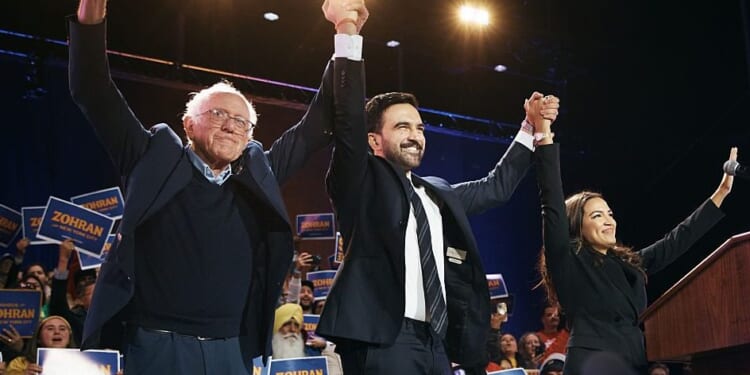Zohran Mamdani, the victor in the New York mayoral election, opened his speech on Tuesday night by honouring one of America’s late, great socialists. “As Eugene Debs once said,” he told his cheering audience, “I can see the dawn of a better day for humanity.” Whether or not socialism becomes a significant force in US politics, his election signals a turning point in contemporary American life: the neoliberal era may be near its end.
The long and bumpy journey there began one hot summer night in 1992, in the same city that gave us Mamdani. Then, Bill Clinton stood before a packed Madison Square Garden to accept the Democratic nomination for president. “The Cold War is over,” he said. “Soviet communism has collapsed and our values — freedom, democracy, individual rights, free enterprise — they have triumphed all around the world.” Having declared the death of socialism, he then outlined a programme to pivot the Democrats towards a new ideology that would “end welfare as we know it” and create a “government that is leaner… that expands opportunity, not bureaucracy… that understands that jobs must come from growth in a vibrant and vital system of free enterprise”.
The previous Democratic president, Jimmy Carter, had begun experimenting with neoliberal policies in the late Seventies — trying deregulation and the use of tight monetary policy to fight inflation — but Clinton went full-hog and made small government the new creed. Its basic premise, that social progress resulted from individuals pursuing their self-interest in an enlightened manner, essentially took Adam Smith’s theory of moral sentiments and gave it a liberal sheen. Most significantly, by burying the Keynesian consensus that had dominated the Party since the days of Franklin D. Roosevelt, Clinton joined the Democrats to the Republicans in a new neoliberal consensus. This doctrine, which would dominate American policy-making for the next three decades, would prioritise free trade and globalisation, deregulation, a leaner state with less generous welfare, low taxes, balanced budgets, and an independent central bank that used monetary policy as the final arbiter of the government’s fiscal rectitude.
Ever since, it’s been an article of orthodoxy among Democrats that no party which welcomed socialists could ever stand a chance outside of America’s liberal heartlands. Candidates could talk a good line on change, as Barack Obama did in his 2008 election campaign, but once in office quickly reasserted the hold of the neoliberal wing on economic policy. Obama did just that when he handed his economic policy-making over to Larry Summers and Timothy Geithner.
Various theories have been put forth to explain the seemingly visceral antipathy Americans have long had to socialism. The frontier thesis posited that European settlement of the West created a culture of rugged individualism; the fragment thesis suggested socialism came to America via German rather than British immigrants, and so was Marxist and counter-cultural rather than Fabian and non-revolutionary. Marxist historian Mike Davis held that organised labour chose not to form a party, as happened in Europe; instead, they hoped to play one party off against the other to secure maximal benefits. Sociologist Barrington Moore believed the outlet of Western settlement acted as a pressure-release valve of urban working classes in 19th-century America’s industrial seaboard. But to this day, polls consistently show that most Americans dislike anything that smacks of communism. Mamdani, for example, polls better in the Big Apple than in the wider country.
That doesn’t mean Americans haven’t been building an appetite for significant change. Over the course of the Obama presidency, the public began turning against the neoliberal consensus, spawning the Occupy movement on the Left and the Tea Party revolt on the Right. But when the 2016 presidential primaries saw insurgent candidates openly challenge the neoliberal orthodoxy, the Republicans succumbed to the anti-free-trade populism of Donald Trump while the Democrats stood firm, delivering the nomination to the uber-establishment Hillary Clinton rather than the self-declared socialist Bernie Sanders.
In hindsight, though, that was the beginning of the end for the Democratic neoliberals. Clinton’s subsequent humiliating defeat at the hands of Trump rankled with the Democratic Left, which pointed to polls that said a hypothetical Sanders-Trump contest would have been won by the Brooklyn-born firebrand (though hypotheticals rarely tell us much). Since then, Left-wing populists have repeatedly surfaced, and the establishment has kept beating them back. Most recently, Alexandria Ocasio-Cortez, who was working as a bartender in the Bronx when she won a shock victory in the 2018 House of Representatives election, found her wings clipped last year when she tried to win the top Democratic position on a powerful House committee, only to be beaten by a septuagenarian. AOC, as she is popularly known, then set off on a nationwide “Fighting Oligarchy” tour with her mentor Sanders, drawing large and enthusiastic crowds in unlikely places such as Oklahoma, Utah and Montana. The tour culminated in September in her native New York City, where the star attraction was none other than Mamdani.
On Tuesday night, more than 30 years after Clinton pronounced socialism dead, the self-declared socialist Zohran Mamdani stood before a raucous crowd as proof that it had risen once more. Like AOC, Mamdani came out of nowhere to rocket to victory. Like AOC, he is a charismatic and articulate master of new media. Like AOC, he deeply unsettles the Party establishment — the Clintons refused to back him, as did Senate leader Chuck Schumer.
But by defeating the establishment and its deep-pocketed backers in a hugely lopsided contest, Mamdani may have given the Left both inspiration and a significant base from which to launch a run for the 2028 presidential election, with AOC frequently topping lists of the papabile. While that possibility still seems a long shot, she and Sanders may well emerge as kingmakers in the Democratic primaries, one way or the other.
“Mamdani may have given the Left both inspiration and a significant base from which to launch a run for the 2028 presidential election”
And while the Party leadership still invokes the need to cleave to the centre, the Left-wing Democrats seem to have two things going in their favour. First, sentiment is shifting. Ever since the bank bailouts that followed the 2008 crash, Americans have grown less enthusiastic about capitalism, with Democratic voters now expressing strong and growing support for socialism. Most notably young voters, who broke strongly for Trump last year, have soured quickly, apparently disappointed that his anti-establishment rhetoric gave way to a warm embrace of tech oligarchs. Meanwhile, Sanders remains one of the most popular politicians in America and even AOC, who is more divisive, enjoys substantially better approval ratings than Trump.
The second thing going for the radicals is that Americans don’t always do what they say they’ll do. The received wisdom in 2016 was that Clinton was a shoo-in because Americans would not vote for a candidate as far outside the mainstream as Trump. But they did, twice. The secret to Trump’s success seems to be that even though he seldom enjoys majority approval, his supporters are so devoted to him that the Party has opened an enthusiasm gap with the Democrats. It may be that the secret to Democratic success lies in a similar strategy: don’t worry if a majority don’t like your candidate, provided a highly-motivated plurality turns out on election day. Mamdani may show how to do it.
While a socialist is still unlikely to win the Democratic nomination for president in 2028, the resurgence of radical populism within the party makes it probable that the next candidate will have to repudiate neoliberalism. In other words, the odds have improved that the 2028 election will pit a MAGA Republican against a Left-wing Democrat. The resulting pyrotechnics might obscure the true significance of that development: a definitive end to the neoliberal era.
A new consensus might not immediately emerge to replace the fallen neoliberal one, given that both parties are engaged in internecine warfare between rival wings. Among the Democrats, the establishment won’t give way without a fight, and they can point to the fact that centrist Democrats did well in other elections on Tuesday night. Among the Republicans, while loyalty to Trump binds the Party together, splits are emerging between different factions as the fight for the 2028 nomination heats up. Policy volatility could result, as one administration after another repeatedly undoes its predecessor’s work, as Trump has done with the Biden administration’s.
Nevertheless, on several points, MAGA Republicans and the Democratic Left seem to be converging — not least because some of Trump’s neoliberal reversions, such as tax cuts, deregulation and a rollback of public health care, have landed uneasily with many of his supporters (witness Marjorie Taylor Greene’s recent meltdowns). But the deeper trends seem increasingly clear. Globalisation will likely diminish as trade deals and immigration policy pay more attention to worker rights and supply-chain resilience. Central bank independence may no longer be sacrosanct, and the Federal Reserve may be expected to underwrite looser government spending. Inflation may consequently settle at the higher level it’s at now. There is likely to be some restoration of regulation, and the tech oligarchs especially may come back into the crosshairs of populists on both sides of the political aisle. Tax policy may be revised to be less favourable to the rich, and more to the middle class. A cross-party consensus on health care reform may yet emerge. In other words, American capitalism may be entering a new and uncertain age. The future could look quite unlike anything we’ve seen before.

















